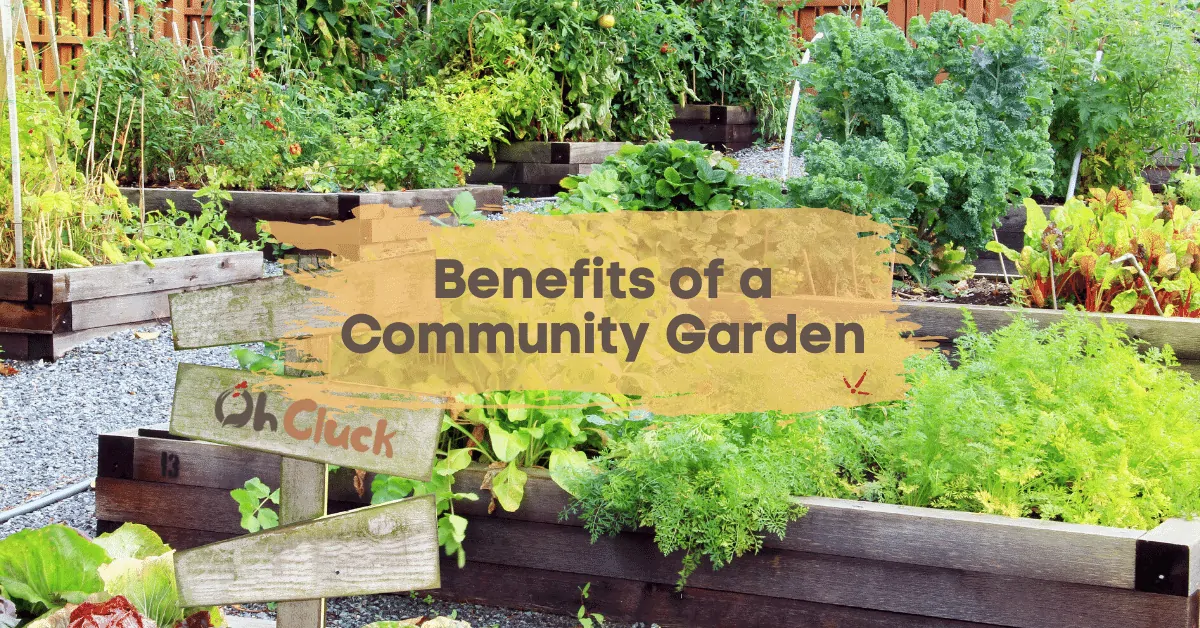There are over one million community gardens in the United States. Over three million people said they would participate in a community garden if one were located near them. This means now more than ever; people are wanting to roll up their sleeves and get their hands dirty while helping grow a positive green community environment.
A community garden serves many excellent purposes, bringing the community together to reach a common goal, educating others about the benefits of raising a garden, improving community appearance, providing quality food for those in need, and much more.
With this article, my goal is to show you how you can create your community garden, expand it to beyond just fruits and vegetables. Now is the perfect time to get your community involved and working together for a common goal. Let’s jump right into it.
What is a Community Garden?
A community garden is a plot of land or set space, that is typically rented by multiple individuals or groups of people with the goal of raising fruits, vegetables, and even small animals, such as chickens. A community garden can be for the private growing of crops, or for the benefit of the community as a whole.
These urban agriculture centers have lots of diversity and are not only just for food production. They can be used for a wide range of needs for the local community, including producing plants for medicinal, ornamental nature, and even spices to serve the community. Another more useful solution to these community gardens is keeping livestock for eggs, milk, meat, wool, and other types of animal products. That can help fill gaps that would otherwise not be available to the local community.
Improve the Look of the Community and Increase Property Value
According to Real Estate Economics, a community garden has a statistically positive impact on the perceived value of the neighborhood, even more so on the most impoverished areas. The higher the quality of the community garden, the more significant the impact on the community is created.
This, however, doesn’t come without its cautions as the study found that once positive impacts have been created, and improvements to the neighborhood have been made, the landowner may reclaim their land.
This is a problem because community gardens often become focal points of communities, a social gathering spot if you will, and can be taken away rather quickly when other social goals, such as public housing, are needed.
For sure this isn’t without controversy and does seem to be a cycle, but setting agendas for the wellness of the community should always be a top priority.
Decrease Violence in Neighborhoods
Research has shown that a community garden can reduce violence in the neighborhood that surrounds it.
According to the research, the crime with and without guns lessened surrounding the neighborhood garden. The reasons considered was the fact that hiding illegal activities is much harder in these type of areas, and because the community garden acted as a unification method for the community, helping build stronger relationships between the residents.
Vandalism also was noticed to take a significant drop surrounding the community garden, and an interesting finding.
A local gathering place that is beneficial to the community health and well being is about more than just food; it’s about bringing a community closer together by sharing common interests and goals. If you could reduce crime and violence while bringing people closer together, isn’t it worth it?
Providing Improved Food Quality
A Sacramento California neighborhood, Del Paso Heights, is about as ethnically diverse as you can get. This low-income community had limited access to healthy food choices and was seeing increase obesity rates due to inadequate access to fresh fruits and vegetables. This community, however, was full of individuals with cultures that valued farming, but they had just one problem, they lacked a space to plant and grow their gardens.
In 1994 a task force created by the community and local government organizations developed a plan to solve this crisis, they made a decision to build a community garden as their first project.
Now, the project is thriving, supporting over 80 families to grow their own fruits and vegetables. Since the establishment of this first community garden, two more have been developed.
Isn’t it amazing what can be accomplished when people come together for the common good of the community?
Learning How to Garden with Other Experienced Gardeners
Bringing together a community for a common purpose, to grow nutritious and delicious food is one of the many benefits of having a community garden.
These community gardens attract experienced gardeners who are eager to share their knowledge and expertise in getting the most crop out of the limited space provided.
A community garden that attracts seasoned gardeners is a fantastic way to allow others who would have other wised showed no interest in growing gardens, to show up, and to learn the basics of how the gardening process works.
Increased Biodiversity
Community gardens contain high levels of biodiversity, even more so than other green spaces that may be within the same city.
The purpose of a community garden goes well beyond just producing fruits and vegetables; it’s a real game-changer. It is allowing for the cultivation of other plants such as medical plants, spices, mushrooms, ornamental plants, mushrooms, and different types of productive plants. Let’s not forget about the ability of a community to produce eggs, meat, milk, and other animal products, such as wool.
A community garden is more than just about food production, it’s for a wide range of needs of the local community.
An also noticeable increase in the diversity of insects, birds, and other wildlife can be noted. The benefits reach farther out than just the local people; it goes out to the wildlife as well.
Finding a need and filling it can start at the center of a community garden.
Improve Dietary Habits Through Education
The benefits of a community garden leaks into improved dietary habits. Educating community members about the nutritional benefits of having access to fresh locally grown produce is key to success in developing positive nutritional habits. Positive eating has a strong relationship to lower BMI and reduce the risk of other diseases that go along with it.
Educating becomes easier when community members can get a hand on experience and see for themselves just how food is grown. Not to say that the local community has to eat the food produced from the community garden itself, but research indicated they are more likely to consume low-fat vegetables.
According to a Harvard study:
“frequent, high-quality opportunities for hands-on nutrition learning, students eat up to three times more fruits and vegetables..”
Harvard University
Physical Health Benefits and Reducing the Risk of Obesity
Research conducted by the University of Utah discovered that those that participated in a community garden had a lower chance of being obese. The study indicated that those that participated in the project BMIs were several points lower than those in the community that didn’t join.
“People who participate in community gardening have a significantly lower body mass index — as well as lower odds of being overweight or obese — than do their non-gardening neighbors.”
University of Utah ( American Journal of Public Health )
It was noted that even the spouses of the participant shared similar BMI lower than those whose spouses did not participate in the program. It was assumed that the spouses would benefit from access to fresh fruits and vegetables that were grown.
Reducing this risk of obesity alone should enough for many communities to consider starting a community garden. Obesity is growing more rampant and causing many more health conditions in our country.
Mental Health Benefits
Studies have shown that living near green spaces, community gardens, and even forests have a direct impact on reducing stress levels.
It was noted in the study that the impacts felt were:
- Reduced mental fatigue
- Lower stress levels
- Better protection against illness
- An overall feeling of better health
This was most likely due to:
- Increased physical activity
- Improved nutrition
- Interacting with each other
As you can see the benefits of having a community center where people can interact, exercise is an excellent way to increase the overall health and wellness of your community as a whole.
Chickens in a Community Garden
Raising chickens in a community garden is an excellent way for the community to learn about self-sufficiency and have access to fresh eggs and meat. Eggs can be donated to locals in need; in fact, many organizations are turning to institutional flocks to feed the local community by providing fresh eggs and meat to local food banks.
Learning how easy it is to raise chickens is another significant step for the community to be able to raise their flock to produce their meat and eggs. By inviting seasoned chicken farmers in the community garden, that goal can be easily reached.
I spoke briefly to Patricia Foreman of The Gossamer Foundation, a nonprofit organization dedicated to global sustainability and local foods.
If you are looking for ways to make your community have a more healthy food program, this is a great solution. The skills they will learn will last a lifetime.
Chickens are cheap to raise and will provide eggs for years, and are also beneficial to the soil through the manure that the drop. A win-win for the chickens and the gardens that surround them.
Once a chicken stops producing eggs they can be harvested for their meat.
She had some insightful information about including chickens in a community garden, that not only are they better nutritionally than massed produced chickens we find in grocery stores, but they are also beneficial to the soil and a community’s being.
She also noted how chickens bring a community closer together, that at this community centers, people aren’t talking about politics, but rather the chickens themselves. Did you see that chicken? Look at her eggs! An interesting discussion for sure.
If you would like to include chickens in your community gardens or non-profit organizations, I highly recommend you contact Patricia Foreman. The program at the Gossamer Foundation they are dedicated to helping community projects reach its goal of having including farm animals, such as chickens in the community gardening projects.
Patricia Foreman
[email protected]
or call: (540) 460–6459
Goats in a Community Garden
Raising goats in a community garden doesn’t come without its challenges, but they are a great source of milk and meat.
It’s important to understand if goats are considered for the garden to make sure they can not reach other community members crops, goats will eat anything they can get their teeth on.
Final Thoughts
A community garden is a great way to bring a community together.
Although it does require work and planning, a little bit of elbow grease, a positive attitude can get the ball rolling.
Starting a community garden will certainly improve the overall health and wellness of the community that surrounds it, there is nothing to lose and only positives to gain.
If you are interested in finding out how you can start your own community garden reach out to nearby landowners, who may have vacant lots available. See what it would take to get used to the land. Talk to your local town hall to see if your ideas can be placed on the agenda to be discussed.
Once people understand the benefits of bringing a community together by serving a common goal, who could say no?
Thanks for reading, feel free to share this article, it will make my day!
Resources
https://www.cdc.gov/healthyplaces/healthtopics/healthyfood/community.htm
https://garden.org/learn/articles/view/3123/
https://www.nal.usda.gov/afsic/community-gardening
http://celosangeles.ucdavis.edu/files/97080.pdf
https://academic.oup.com/aje/article/174/11/1296/111352?keytype=ref&ijkey=9pNc5FdhqLOAvbU
https://www.communitygarden.org/resources/category/community-garden-management
https://furmancenter.org/files/publications/The_Effect_of_Community_Gardens.pdf
https://archive.unews.utah.edu/news_releases/community-gardens-may-produce-more-than-vegetables-2/
https://www.gse.harvard.edu/news/uk/18/07/let-it-grow
https://www.sciencedirect.com/science/article/pii/S2211335516301401
OhCluck.com is a participant in the Amazon Services LLC Associates Program, an affiliate advertising program designed to provide a means for sites to earn advertising fees by advertising and linking to Amazon.com
Comments
0 comments

